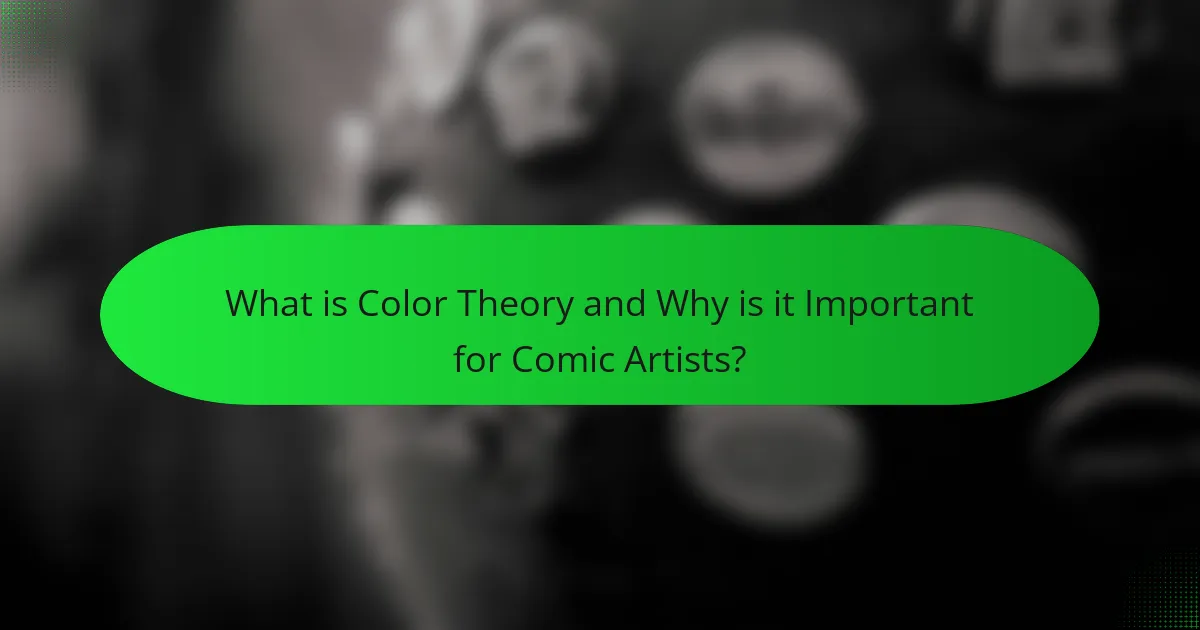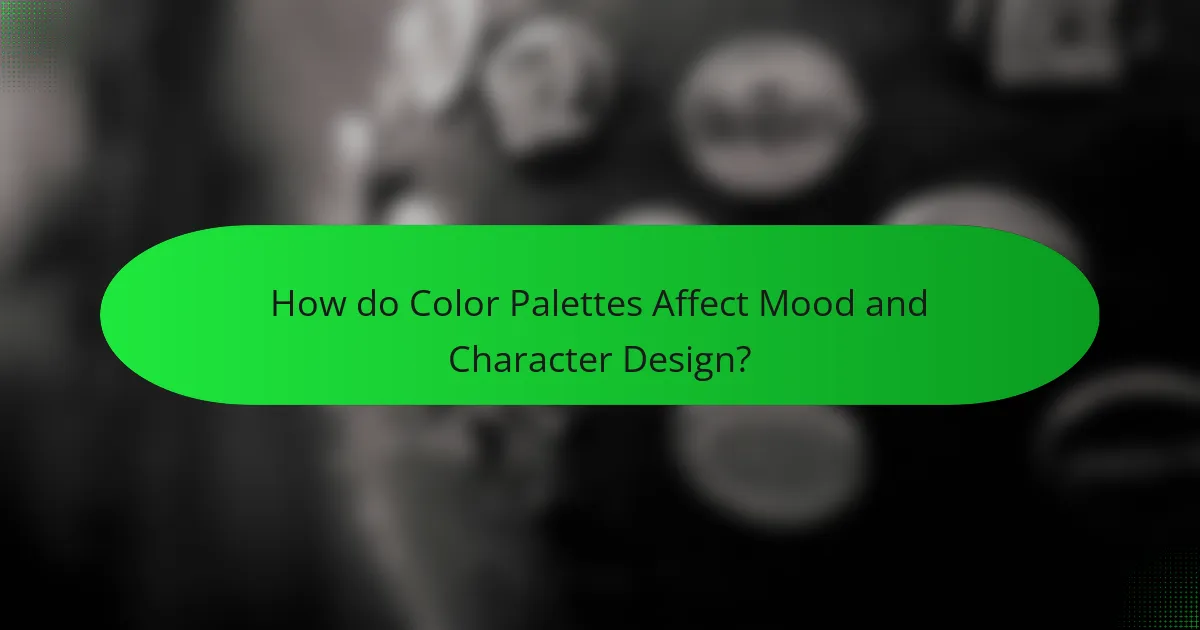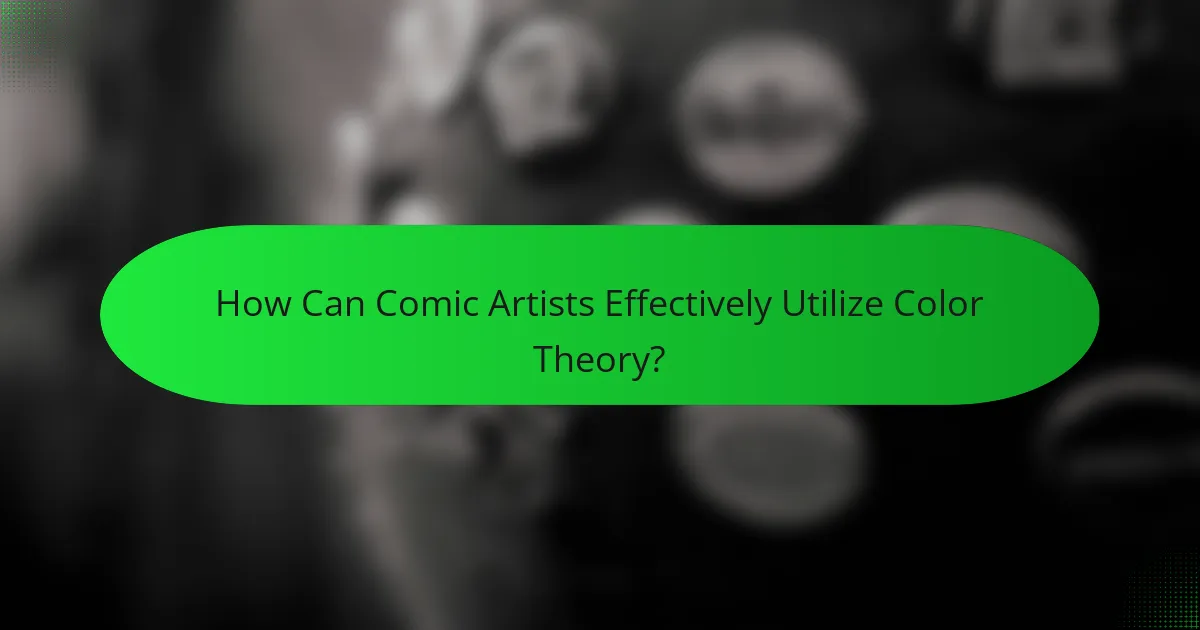Color theory is a framework that explains how colors interact and affect viewers, playing a vital role in comic art. This article explores the significance of color palettes in enhancing mood, character design, and storytelling. It discusses the emotional impacts of warm and cool colors, how they can influence audience perception, and the importance of harmonious color relationships. Additionally, the article highlights practical applications of color theory, including the use of the color wheel and the benefits of limited color palettes for creating visual identity in characters. Understanding these concepts enables comic artists to effectively communicate themes and emotions through their artwork.

What is Color Theory and Why is it Important for Comic Artists?
Color theory is a framework that explains how colors interact and the effects they have on viewers. It is crucial for comic artists because it helps them create visually appealing and emotionally resonant artwork. Understanding color relationships can enhance storytelling by influencing mood and atmosphere. For example, warm colors like red and orange evoke energy, while cool colors like blue and green convey calmness. Additionally, color theory guides artists in choosing palettes that complement character design and enhance narrative elements. By applying these principles, comic artists can effectively communicate themes and emotions, making their work more impactful.
How does Color Theory influence visual storytelling in comics?
Color theory significantly influences visual storytelling in comics by guiding the emotional tone and narrative clarity. Colors can evoke specific feelings, such as blue for sadness or red for excitement. Artists utilize color palettes to establish mood and character traits. For instance, a warm palette may suggest warmth or friendliness. In contrast, a cool palette often conveys detachment or tension.
Color choices also enhance visual hierarchy. Key elements can be highlighted using contrasting colors, directing the reader’s attention effectively. This technique improves comprehension of the narrative. Additionally, color consistency helps maintain a cohesive visual style throughout the comic.
Historical examples demonstrate this impact. Works like “The Adventures of Tintin” use color strategically to enhance storytelling. The careful selection of hues aids in character development and plot progression. Thus, color theory is essential for effective visual storytelling in comics.
What are the basic principles of Color Theory?
The basic principles of Color Theory include the color wheel, color harmony, and color context. The color wheel organizes hues in a circular format. It typically includes primary, secondary, and tertiary colors. Color harmony refers to aesthetically pleasing combinations of colors. These combinations create balance and visual interest. Common harmonies include complementary, analogous, and triadic schemes. Color context examines how colors interact with each other. This principle shows that colors can appear different depending on surrounding colors. Understanding these principles is essential for effective color usage in art and design.
How do color relationships affect narrative tone?
Color relationships significantly influence narrative tone in visual storytelling. They evoke emotions and set the atmosphere of a scene. For example, warm colors like red and orange can create feelings of excitement or anger. In contrast, cool colors like blue and green often evoke calmness or sadness.
The use of complementary colors can create tension and contrast, enhancing dramatic moments. Analogous colors, which are next to each other on the color wheel, can create harmony and unity in a narrative. According to the research by Birren, “Color Psychology and Color Therapy” (1997), colors can affect mood and perception, supporting their role in narrative tone.
Therefore, thoughtful color relationships can guide audience emotions and responses throughout a narrative.
What are the different color models used in comic art?
The different color models used in comic art include RGB, CMYK, and HSL. RGB stands for Red, Green, and Blue. It is primarily used for digital art. This model combines light to create colors on screens. CMYK stands for Cyan, Magenta, Yellow, and Key (Black). It is used in print media. This model combines inks to produce colors on paper. HSL stands for Hue, Saturation, and Lightness. It is often used for color selection in design software. Each model serves distinct purposes based on the medium of the comic art. Understanding these models is crucial for effective color application in comics.
What is the RGB color model and how is it applied?
The RGB color model is a system for representing colors through the combination of red, green, and blue light. Each color is created by varying the intensity of these three primary colors. The model is widely used in digital displays, such as computer monitors and televisions. In this model, colors are typically represented as numerical values ranging from 0 to 255 for each component. For example, pure red is represented as (255, 0, 0), while white is (255, 255, 255).
Application of the RGB model is crucial in comic art for creating vibrant and dynamic visuals. Artists use RGB values to ensure consistency across digital platforms. This model allows for precise color manipulation in graphic design software. Understanding RGB helps artists achieve the desired mood and character design through color selection. The model’s relevance is evident in the digital nature of modern comic creation.
What is the CMYK color model and its significance for printing?
The CMYK color model is a subtractive color model used in color printing. It stands for Cyan, Magenta, Yellow, and Key (Black). This model is significant for printing because it accurately represents how colors combine on paper. In CMYK, colors are created by subtracting varying percentages of light absorbed by these four inks. This allows for a wide range of colors to be produced in printed materials.
The printing process relies on this model to ensure that the final output matches the intended design. Each color in the model is mixed in specific proportions to achieve the desired hue. The CMYK model is essential in the graphic design and printing industries, as it directly influences the quality and accuracy of printed images.

How do Color Palettes Affect Mood and Character Design?
Color palettes significantly influence mood and character design. Different colors evoke specific emotions. For instance, warm colors like red and orange can create feelings of excitement or anger. In contrast, cool colors such as blue and green often convey calmness or sadness.
Character design benefits from color palettes by establishing visual identity. A hero might use bright, bold colors to signify strength and positivity. Meanwhile, a villain may be depicted with darker tones to suggest mystery or danger.
Research shows that color psychology plays a crucial role in audience perception. According to “The Impact of Color on Marketing” by Satyendra Singh, color increases brand recognition by up to 80%. This principle applies to character design as well, where color choices can enhance storytelling and character relatability.
What is a color palette and how do artists choose one?
A color palette is a selection of colors used in a piece of art. Artists choose a color palette based on the mood they want to convey. They consider color theory principles, such as complementary and analogous colors. Artists also draw inspiration from their subject matter and personal style. The chosen palette can enhance emotional impact and storytelling. For example, warm colors may evoke feelings of energy, while cool colors can create calmness. Ultimately, the selection process is both analytical and intuitive.
What are the common types of color palettes used in comics?
The common types of color palettes used in comics include monochromatic, complementary, analogous, triadic, and split-complementary palettes. Monochromatic palettes utilize variations of a single color. This approach creates a cohesive and harmonious visual effect. Complementary palettes use colors opposite each other on the color wheel. This technique enhances contrast and visual interest. Analogous palettes consist of colors next to each other on the wheel. They provide a more subtle and unified look. Triadic palettes feature three evenly spaced colors on the wheel. This method creates a vibrant and dynamic composition. Split-complementary palettes combine one base color with two adjacent complementary colors. This offers balance and variety while maintaining harmony. These palettes are widely recognized and utilized in comic art for effective storytelling and character design.
How can color palettes enhance character emotions?
Color palettes enhance character emotions by visually conveying feelings and moods. Different colors evoke specific emotional responses. For example, warm colors like red and orange can create feelings of passion or anger. Conversely, cool colors such as blue and green often evoke calmness or sadness.
In character design, the choice of colors can signal a character’s emotional state to the audience. Bright, saturated colors can indicate joy or excitement. Muted tones may suggest melancholy or introspection.
Research shows that color psychology plays a significant role in perception. Studies indicate that people associate certain colors with specific emotions consistently. For instance, a study by K. H. K. Heller and A. B. K. M. L. Heller found that color influences emotional responses across various cultures.
Thus, using color palettes effectively can deepen audience engagement with characters by aligning visual elements with emotional narratives.
What role does color play in character differentiation?
Color plays a critical role in character differentiation by establishing visual identity and conveying personality traits. Different colors evoke specific emotions and associations. For example, red often symbolizes passion or aggression, while blue can represent calmness or trustworthiness. In character design, the strategic use of color helps audiences quickly identify and relate to characters. Research indicates that color influences perception and memory, making it easier for viewers to distinguish between characters. A study published in the journal “Color Research and Application” by researchers H. K. K. D. and J. S. K. found that color significantly affects character recognition and emotional responses. Thus, color is essential for effective character differentiation in visual storytelling.
How can contrasting colors be used to highlight character traits?
Contrasting colors can effectively highlight character traits by creating visual emphasis and emotional responses. For example, a character dressed in warm colors like red may convey passion or aggression, while cooler colors like blue can suggest calmness or sadness. This visual dichotomy draws attention to the character’s emotional state or personality.
In comic art, contrasting colors can also differentiate characters, making them memorable. For instance, a hero in bright colors can symbolize vibrancy and optimism, while a villain in dark shades may evoke fear and mystery. Studies in color psychology support this, showing that colors can influence perceptions of personality traits.
Using contrasting colors strategically can enhance storytelling and deepen audience engagement. This approach allows artists to communicate complex character dynamics visually and instantly.
What are some examples of effective color use in character design?
Effective color use in character design includes the use of complementary colors, monochromatic schemes, and color symbolism. Complementary colors create visual interest and contrast, enhancing character features. For example, characters like the Joker use green and purple to signify chaos and madness. Monochromatic schemes establish mood and cohesion, as seen in characters like Batman, who primarily uses dark blues and blacks. Color symbolism conveys traits; red often represents passion or danger, like in characters such as Spider-Man. These techniques are employed to evoke specific emotional responses from the audience and to reinforce character identities.

How Can Comic Artists Effectively Utilize Color Theory?
Comic artists can effectively utilize color theory by understanding color relationships and emotional impacts. They should start with the color wheel to identify primary, secondary, and tertiary colors. This knowledge helps in creating harmonious palettes. Utilizing complementary colors can enhance contrast and focus on important elements. Analogous colors can create a sense of unity and cohesion in a scene. Artists should also consider color temperature; warm colors evoke energy, while cool colors convey calmness. Additionally, using a limited color palette can create a strong visual identity for characters. According to a study by the University of California, colors can significantly influence audience perception and emotional response in visual storytelling.
What techniques can artists employ to master color application?
Artists can employ techniques such as color mixing, layering, and glazing to master color application. Color mixing involves combining different pigments to create new shades. This technique allows artists to achieve desired hues and tones. Layering refers to applying multiple layers of color to build depth and richness. This method enhances the visual complexity of the artwork. Glazing is the application of thin, transparent layers of paint over dry layers. This technique can create luminosity and subtle color shifts. Additionally, artists can utilize color theory principles, such as complementary colors and analogous color schemes, to create harmony and contrast. Understanding these techniques is essential for effective color application in comic art.
How can color contrast be used to guide reader focus?
Color contrast can effectively guide reader focus by creating visual hierarchy. High contrast between text and background enhances readability. For example, black text on a white background is easy to read. Similarly, contrasting colors can highlight key elements in a comic panel. This draws attention to important characters or actions. Research shows that color contrast influences viewer perception and engagement. A study by the University of Alberta found that contrast enhances information retention. Therefore, using color contrast strategically can lead to a more impactful narrative experience.
What are the best practices for creating harmonious color schemes?
Best practices for creating harmonious color schemes include using a color wheel to identify complementary colors. Complementary colors are opposite each other on the wheel. This contrast creates visual interest. Analogous colors, which are next to each other on the wheel, provide a more subtle harmony. Using a limited color palette helps maintain consistency. Consider the emotional impact of colors, as different hues evoke different feelings. Balance warm and cool colors to create depth. Test color combinations in small areas before applying them broadly. These practices ensure that the final design is visually appealing and cohesive.
What common mistakes should comic artists avoid when using color?
Comic artists should avoid using too many colors in a single panel. This can create visual chaos and distract from the narrative. They should also ensure that colors are consistent across characters and settings. Inconsistency can confuse readers about the story and characters. Another mistake is neglecting color contrast. Poor contrast can make elements difficult to distinguish, impacting readability. Additionally, artists should avoid using overly saturated colors. This can overwhelm the viewer and detract from the overall aesthetic. Lastly, not considering the emotional impact of colors can lead to miscommunication of tone. Colors convey mood and should align with the story’s themes.
How can over-saturation affect the overall artwork?
Over-saturation can significantly diminish the overall impact of artwork. It can create a visual imbalance that distracts viewers. When colors are overly saturated, they may clash rather than harmonize. This can lead to a chaotic appearance in the artwork. The intended mood or emotion may be lost due to overwhelming brightness. Artists often aim for a balance between saturation and desaturation. Studies show that color harmony enhances viewer engagement. Therefore, managing saturation is crucial for effective visual storytelling.
What are the pitfalls of using colors without understanding their meaning?
Using colors without understanding their meaning can lead to miscommunication and negative emotional responses. For instance, red typically signifies danger or passion, while blue often conveys calmness or trust. Misusing these colors can confuse the intended message of a comic. Additionally, colors can evoke cultural associations. For example, white symbolizes purity in some cultures but mourning in others. Ignoring these associations may alienate or offend audiences. Furthermore, contrasting colors can create visual discord if not applied thoughtfully. This can detract from the overall aesthetic and storytelling. Ultimately, a lack of understanding can undermine the effectiveness of character design and mood setting in comics.
What are some practical tips for applying color theory in comic art?
Use a limited color palette to create consistency. This helps unify the comic’s visual style. Choose colors based on emotional impact. For example, warm colors can evoke excitement, while cool colors may suggest calmness. Utilize complementary colors to create contrast and draw attention to key elements. This technique enhances visual interest. Apply analogous colors for harmony in scenes. This approach can create a cohesive atmosphere. Consider the color wheel as a guide for selecting colors. It visually represents relationships between colors. Use shading and tinting to add depth. This technique can enhance the three-dimensionality of characters and environments. Lastly, test color combinations digitally before finalizing. This allows for adjustments and ensures the desired effect.
Color theory is a crucial framework for comic artists that explains how colors interact and affect viewers, enhancing visual storytelling and emotional resonance. This article covers the principles of color theory, including color models like RGB and CMYK, and how color palettes influence mood and character design. It explores techniques for effective color application, common mistakes to avoid, and practical tips for creating harmonious color schemes. By understanding these concepts, comic artists can improve their work’s impact and clarity, guiding audience emotions and enhancing narrative elements.